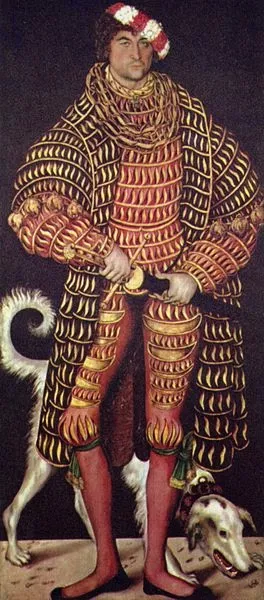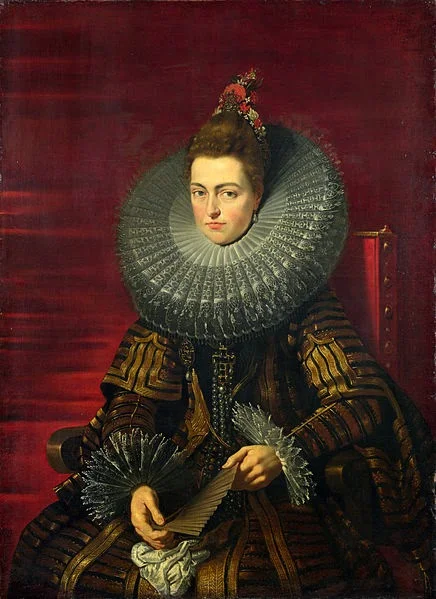Early Modern Europe
By the first half of the 16th century, the clothing of the Low Countries, German states, and Scandinavia had developed in a different direction than that of England, France, and Italy, although all absorbed the sobering and formal influence of Spanish dress after the mid-1520s.
 Elaborate slashing was popular, especially in Germany. Black was increasingly worn for the most formal occasions. Bobbin lace arose from passementerie in the mid-16th century, probably in Flanders. This century also saw the rise of the ruff, which grew from a mere ruffle at the neckline of the shirt or chemise to immense cartwheel shapes. At their most extravagant, ruffs required wire supports and were made of fine Italian reticella, a cutwork linen lace.
Elaborate slashing was popular, especially in Germany. Black was increasingly worn for the most formal occasions. Bobbin lace arose from passementerie in the mid-16th century, probably in Flanders. This century also saw the rise of the ruff, which grew from a mere ruffle at the neckline of the shirt or chemise to immense cartwheel shapes. At their most extravagant, ruffs required wire supports and were made of fine Italian reticella, a cutwork linen lace.
By the turn of the 17th century, a sharp distinction could be seen between the sober fashions favored by Protestants in England and the Netherlands, which still showed heavy Spanish influence, and the light, revealing fashions of the French and Italian courts.
The great flowering of needlelace occurred in this period. Geometric reticella deriving from cutwork was elaborated into true needlelace or punto in aria (called in England "point lace"), which reflected the scrolling floral designs popular for embroidery. Lacemaking centers were established in France to reduce the outflow of cash to Italy.
According to Dr. Wolf D. Fuhrig, "By the second half of the 17th century, Silesia had become an important economic pillar of the Habsburg monarchy, largely on the strength of its textile industry."
Main articles: 1500–1550 in fashion, 1550–1600 in fashion, 1600–1650 in fashion, and 1650–1700 in fashion
Enlightenment and the Colonial period
During the eighteenth century, distinction was made between full dress worn at Court and for formal occasions, and undress or every day, daytime clothes. As the decades progressed, fewer and fewer occasions called for full dress which had all but disappeared by the end of the century. Full dress followed the styles of the French court, where rich silks and elaborate embroidery reigned. Men continued to wear the coat, waistcoat and breeches for both full dress and undress; these were now sometimes made of the same fabric and trim, signalling the birth of the three-piece suit.
Women's silhouettes featured small, domed hoops in the 1730s and early 1740s, which were displaced for formal court wear by side hoops or panniers which later widened to as much as three feet to either side at the court of Marie Antoinette. Fashion reached heights of fantasy and abundant ornamentation, before new enthusiasms for outdoor sports and country pursuits and a long-simmering movement toward simplicity and democratization of dress under the influence of Jean-Jacques Rousseau and the American Revolution led to an entirely new mode and the triumph of British woollen tailoring following the French Revolution.
For women's dresses, Indian cottons, especially printed chintzes, were imported to Europe in large numbers, and towards the end of the period simple white muslin gowns were in fashion.
Main articles: 1700–1750 in fashion and 1750–1795 in fashion
Industrial revolution
During the industrial revolution, fabric production was mechanised with machines powered by waterwheels and steam-engines. Production shifted from small cottage based production to mass production based on assembly line organisation. Clothing production, on the other hand, continued to be made by hand.
Sewing machines emerged in the 19th century streamlining clothing production.
In the early 20th century workers in the clothing and textile industries became unionised. Later in the 20th century, the industry had expanded to such a degree that such educational institutions as UC Davis established a Division of Textiles and Clothing, The University of Nebraska-Lincoln also created a Department of Textiles, Clothing and Design that offers a Masters of Arts in Textile History and Iowa State University established a Department of Textiles and Clothing that features a History of costume collection, 1865–1948. Even high school libraries have collections on the history of clothing and textiles.
Alongside these developments were changes in the types and style of clothing produced. During the 1960s, had a major influence on subsequent developments in the industry.
Textiles were not only made in factories. Before this that they were made in local and national markets. Dramatic change in transportation throughout the nation is one source that encouraged the use of factories. New advances such as steamboats, canals, and railroads lowered shipping costs which caused people to buy cheap goods that were produced in other places instead of more expensive goods that were produced locally. Between 1810 and 1840 the development of a national market prompted manufacturing which tripled the output’s worth. This increase in production created a change in industrial methods, such as the use of factories instead of handmade woven materials that families usually made.
The vast majority of the people who worked in the factories were women. Women went to work in textile factories for a number of reasons. Some women left home to live on their own because of crowding at home; or to save for future marriage portions. The work enabled them to see more of the world, to earn something in anticipation of marriage, and to ease the crowding within the home. They also did it to make money for family back home. The money they sent home was to help out with the trouble some of the farmers were having. They also worked in the mill houses because they could gain a sense of independence and growth as a personal goal.
Main article: Textile manufacture during the Industrial Revolution







0 Comments